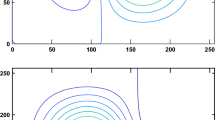Abstract
The common defects of the Roe scheme are the non-physical expansion shock and shock instability. By removing the momentum interpolation mechanism (MIM), an improved method with several advantages has been presented to suppress the shock instability. However, it cannot prevent the expansion shock and is incompatible with the traditional curing method for expansion shock. To solve the problem, the traditional curing mechanism is analyzed. Effectiveness of the traditional curing method is discussed, and several defects are identified, one of which leads to incompatibility between curing shock instability and expansion shock. Consequently, an improved Roe scheme is proposed, which is with low computational costs, concise, easy to implement, and robust. More importantly, the proposed scheme can simultaneously solve the problem of shock instability and expansion shock without additional costs.
Similar content being viewed by others
References
Roe, P. L. Approximate Riemann solvers: parameter vectors and difference schemes. Journal of Computational Physics, 43, 357–372 (1981)
Guillard, H. and Viozat, C. On the behaviour of upwind schemes in the low Mach number limit. Computers and Fluids, 28, 63–86 (1999)
Huang, D. G. Unified computation of flow with compressible and incompressible fluid based on Roe’s scheme. Applied Mathematics and Mechanics (English Edition), 27, 758–763 (2006) https://doi.org/10.1007/s10483-006-0606-1
Li, X. S. and Gu, C. W. Mechanism of Roe-type schemes for all-speed flows and its application. Computers and Fluids, 86, 56–70 (2013)
Kitamura, K., Shima, E., Fujimoto, K., and Wang, Z. J. Performance of low-dissipation Euler fluxes and preconditioned LU-SGS at low speeds. Communications in Computational Physics, 10, 90–119 (2011)
Garnier, E., Mossi, M., Sagaut, P., Comte, P., and Deville, M. On the use of shock-capturing schemes for large-eddy simulation. Journal of Computational Physics, 153, 273–311 (1999)
Li, X. S. and Li, X. L. All-speed Roe scheme for the large eddy simulation of homogeneous decaying turbulence. International Journal of Computational Fluid Dynamics, 30, 69–78 (2016)
Huang, D. G. Preconditioned dual-time procedures and its application to simulating the flow with cavitations. Journal of Computational Physics, 223, 685–689 (2007)
Quirk, J. J. A contribution to the great Riemann solver debate. International Journal for Numerical Methods in Fluids, 18, 555–574 (1994)
Kermani, M. J. and Plett, E. G. Modified entropy correction formula for the Roe scheme. 39th AIAA Aerospace Sciences Meeting and Exhibit, American Institute of Aeronautics and Astronautics, Reno, 2001–0083 (2001)
Qu, F., Yan, C., Sun, D., and Jiang, Z. A new Roe-type scheme for all speeds. Computers and Fluids, 121, 11–25 (2015)
Kim, S., Kim, C., Rho, O. H., and Hong, S. K. Cures for the shock instability: development of a shock-stable Roe scheme. Journal of Computational Physics, 185, 342–374 (2003)
Ren, Y. X. A robust shock-capturing scheme based on rotated Riemann solvers. Computers and Fluids, 32, 1379–1403 (2003)
Nishikawa, H. and Kitamura, K. Very simple, carbuncle-free, boundary-layer-resolving, rotatedhybrid Riemann solvers. Journal of Computational Physics, 227, 2560–2581 (2008)
Einfeldt, B., Munz, C. D., Roe, P. L., and Sjögreen, B. On Godunov-type methods near low densities. Journal of Computational Physics, 92, 273–295 (1991)
Liou, M. S. A sequel to AUSM II: AUSM+-up for all speeds. Journal Computational Physics, 214, 137–170 (2006)
Ren, X. D., Gu, C. W., and Li, X. S. Role of momentum interpolation mechanism of the Roe scheme in shock instability. International Journal for Numerical Methods in Fluids, 84, 335–351 (2017)
Li, X. S., Xu, J. Z., and Gu, C. W. Preconditioning method and engineering application of large eddy simulation. Science in China Series G: Physics, Mechanics and Astronomy, 51, 667–677 (2008)
Li, X. S. and Gu, C. W. The momentum interpolation method based on the time-marching algorithm for all-speed flows. Journal of Computational Physics, 229, 7806–7818 (2010)
Pascau, A. Cell face velocity alternatives in a structured colocated grid for the unsteady Navier-Stokes equations. International Journal for Numerical Methods in Fluids, 65, 812–833 (2011)
Weiss, J. M. and Smith, W. A. Preconditioning applied to variable and const density flows. AIAA Journal, 33, 2050–2057 (1995)
Li, X. S. Uniform algorithm for all-speed shock-capturing schemes. International Journal of Computational Fluid Dynamics, 28, 329–338 (2014)
Van Leer, B. Towards the ultimate conservative difference scheme V: a second-order sequel to Godunov’s method. Journal of Computational Physics, 32, 101–136 (1979)
Huang, D. G. and Li, X. S. Rotordynamic characteristics of a rotor with labyrinth gas seals.: comparison with Childs’ experiments. Proceedings of the Institution of Mechanical Engineers, Part A: Journal of Power and Energy, 218, 171–177 (2004)
Huang, D. G. and Li, X. S. Rotordynamic characteristics of a rotor with labyrinth gas seals/: a non-linear model. Proceedings of the Institution of Mechanical Engineers, Part A: Journal of Power and Energy, 218, 179–185 (2004)
Su, X. R., Sasaki, D., and Nakahashi, K. Cartesian mesh with a novel hybrid weno/meshless method for turbulent flow calculations. Computers and Fluids, 84, 69–86 (2013)
Su, X. R., Sasaki, D., and Nakahashi, K. On the efficient application of weighted essentially nonoscillatory scheme. International Journal for Numerical Methods in Fluids, 71, 185–207 (2013)
Author information
Authors and Affiliations
Corresponding author
Additional information
Project supported by the National Natural Science Foundation of China (Nos. 51736008 and 51276092)
Rights and permissions
About this article
Cite this article
Li, X., Ren, X. & Gu, C. Cures for expansion shock and shock instability of Roe scheme based on momentum interpolation mechanism. Appl. Math. Mech.-Engl. Ed. 39, 455–466 (2018). https://doi.org/10.1007/s10483-017-2283-8
Received:
Revised:
Published:
Issue Date:
DOI: https://doi.org/10.1007/s10483-017-2283-8




